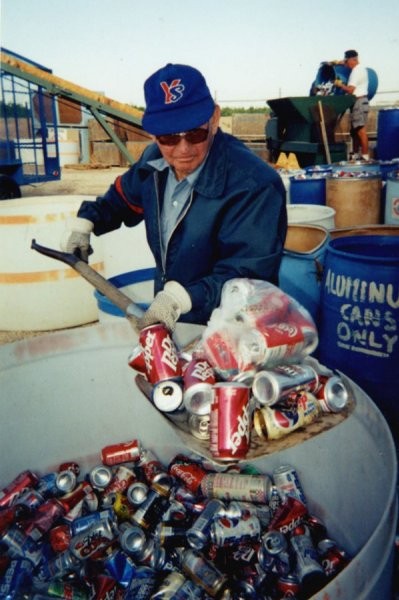Taking the world’s most recycled beverage packaging container to new heights

by Heidi Biggs Brock, President, Aluminum Association
It’s a well-known but sad fact among recycling experts that the U.S. aluminum can recycling rate peaked in the early 1990s; after peaking, the rate dropped dramatically, and has slowly been recovering since that time.
The 2010 recycling rate was the highest in a decade at 58.1 percent – with nearly 56 billion aluminum cans recycled – according to the calculations of the Aluminum Association and its partner organizations, the Can Manufacturers Institute and the Institute of Scrap Recycling Industries. This recycling rate makes the aluminum can by far the most recycled beverage packaging container.
While the U.S. rate is growing, the Canadian rate is at 66 percent – much closer to the worldwide recycle rate of 65 percent (as calculated by the International Aluminum Institute.)
“Aluminum cans have proven to be the most recycled and most recyclable beverage container; in fact, they are the only packaging solution that is 100 percent recyclable,” notes Nancy Kratky of ThomasNet News, in her coverage of the 2010 recycling rate increase.
For over six decades, recycled aluminum has been an integral part of the U.S. aluminum industry’s feedstock. In 1997 the supply of secondary aluminum surpassed primary aluminum for the first time. Can recycling has been critical to maintaining that supply of lower-cost, high-grade secondary aluminum.
“It is great to see someone cross the street to use a recycling bin instead of the trash can right next to them,” says Allison Buchanan, Marketing Communications Manager for Alcoa’s Rigid Packaging Division and Chair of the Aluminum Association’s Can Committee.
“I really think people are starting to understand how important recycling is – and that tossing a can in the trash is equivalent to wasting half its volume in gasoline.”
“The aluminum can’s recycling story is one of the best examples of the industry’s commitment to sustainability,” Buchanan continues. “Can recycling started in the 1960s and has grown to become part of everyday Americans’ lives.”
By the 1970s, the aluminum industry had put in place a recycling infrastructure that would allow for the reclamation and recycling of aluminum cans in a closed-loop process – boosting the recycled content of each can to new levels with each increase in the recycling rate. Today’s aluminum can boasts an average of 68 percent recycled content – the highest of any beverage packaging material – and the typical can is recycled to become a new can in as little as 60 days.
Notwithstanding these achievements, the Aluminum Association is not satisfied with the pace of progress on growing the can recycling rate. In 2008 the Association committed to boosting the recycling rate to 75 percent.
“We knew 75 percent wouldn’t be easy,” says Buchanan. “It was meant to be a goal and a challenge. Not only to our industry, but to each and every American as we work together in driving the recycle rate in the US closer to the global average of 65 percent.”
The Curbside Value Partnership
Municipalities are typically eager to incorporate aluminum into their recycling programs, because – as the most valuable material in the consumer waste stream – aluminum effectively subsidizes the collection of other, less-precious items in many curbside systems.
For this reason, the Aluminum Association and partners have been working with municipal recycling authorities to boost recycling via the Curbside Value Partnership (CVP). Established in 2003 by the Aluminum Association and the Can Manufacturers Institute, the CVP has launched and measured programs in 27 communities and four states. CVP is now a fully independent organization that identifies communities that are underachieving in their recycling efforts and works with them to grow participation in their programs and measure that growth to provide the benchmark for continued success in the future. Communities partnering with CVP have boosted their average annual recycled materials per household to 368 pounds.
“Even though CVP started as a joint venture between the Can Manufacturers Institute and the Aluminum Association, it is material neutral and seeks to increase the recovery of all recyclables,” explains David Gill, Global Account Director for Novelis, Inc. and Chairman of CVP’s Board of Directors. “In fact, CVP has undergone reorganization and has invited other commodities to join the Board. Recycling aluminum, paper, plastic, steel, and glass is important, and CVP works to improve education and awareness about local recycling and the importance of recycling to communities and future generations.”
Aluminum can usage is increasing, and the Aluminum Association is committed to continuing to raise the recycling rate along with it.
“More recycled cans means more energy and emission savings,” adds Buchanan. “Recycled aluminum requires only five percent of the energy, and generates only five percent of the emissions associated with aluminum made from ore. That’s the very essence of sustainability.”


